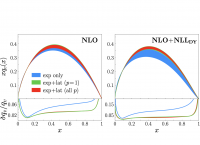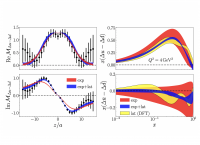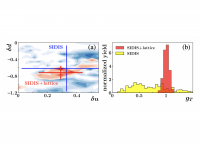See below for highlights of unpolarized PDFs from JAM. Click images for enlargement.
PION PARTON DISTRIBUTIONS: COMPLEMENTARITY OF EXPERIMENTAL AND LATTICE QCD DATA
A new paper by the JAM and HadStruc collaborations reports the extraction of the pion parton distribution functions (PDFs) in a Monte Carlo global Quantum Chromodynamics (QCD) analysis of experimental data together with pseudo-PDFs and matrix elements generated from lattice QCD. By including both experimental and lattice QCD data, the analysis rigorously quantifies both the uncertainties of the pion PDFs and systematic effects intrinsic to the lattice QCD observables. Consistent with recent phenomenological determinations, the behavior of the valence quark distribution of the pion at large momentum fraction is found to be ∼(1−x)β, where β=1.0-1.2.
CONFRONTING LATTICE PARTON DISTRIBUTIONS WITH GLOBAL QCD ANALYSIS
A collaboration between nuclear theorists and lattice QCD practitioners has presented the first Monte Carlo-based global QCD analysis of spin-averaged and spin-dependent parton distribution functions that includes nucleon lattice matrix elements in coordinate space and treats lattice and experimental data under the same conditions. For the unpolarized sector, the study reveals difficulties in describing the lattice matrix elements at large spatial distances simultaneously with the experimental results. In contrast, good agreement is found in the polarized case between experiment and lattice data, with the latter providing significant constraints on the spin-dependent isovector quark and antiquark distributions.
FIRST MONTE CARLO GLOBAL ANALYSIS OF NUCLEON TRANSVERSITY WITH LATTICE QCD CONSTRAINTS
The first global QCD analysis of the quark transversity distributions in the nucleon has been performed, using a new Monte Carlo method based on nested sampling and constraints on the isovector tensor charge gT from lattice QCD. A simultaneous fit to the semi-inclusive Collins asymmetry data is compatible with gT values extracted from a comprehensive reanalysis of existing lattice simulations, in contrast to previous analyses which found significantly smaller gT values. The contributions to the nucleon tensor charge from u and d quarks are found to be Δu = 0.3(2) and Δd = -0.7(2) at a scale Q2 = 2 GeV2 .




